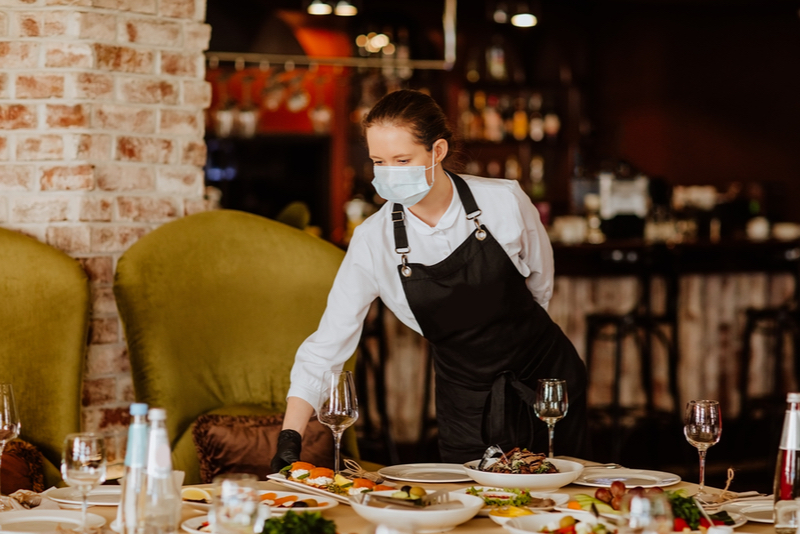What’s Hot: Restaurant Revitalization Fund Already Running Out of Funds
Restaurants have struggled to stay open, pivot to delivery, complete take-out orders, set-up outdoor dining throughout the cold winter, and to pay rent. When the March 2021 American Rescue Plan stimulus bill included a $28.6 billion Restaurant Revitalization Fund, much needed financial support was provided in the form of grants, rather than loans, to restaurant owners. The fund started accepting applications on May 3, and just two weeks later, the Small Business Administration (SBA) had received more than 250,000 applicants requesting a total of $65 billion in financial aid, which is more than double the amount of money in the fund.
Eater reports that restaurant owners, lobbyists, and food industry activists are frustrated that the financial aid will leave many restaurant owners without assistance. While their frustration is justified and aid is limited, the SBA has prioritized processing applications from businesses owned by women, veterans and people from economically and socially disadvantaged groups during the first three weeks of the fund’s rollout.
In addition, the Los Angeles Times notes that Rep. Earl Blumenauer (D-Ore.) is working with House and Senate leaders to replenish the Restaurant Revitalization Fund, and hopes that more money will be approved once his colleagues see how popular the grants are and how much needed the financial aid is.
Food Policy Watchdog: Bill Introduced to Make All Meals Free in Schools for All Students
Earlier in May, Senators Bernie Sanders (I-Vt.) and Kirsten Gillibrand (D-N.Y.) and Representatives Ilhan Omar (D-Minn.) and Gwen Moore (D-Wis.) announced legislation to expand on the universal free lunch program that was extended by the USDA in April. The Universal School Meals Program Act of 2021 would provide free breakfast, lunch, dinner, and a snack to all school children on a permanent basis, regardless of family income. Additionally, this bill focuses on eliminating school meal debt, since many schools are only able to get reimbursed for meals that have been picked up by students, and incentivizing local food procurement to strengthen local economies.
Due to the COVID-19 pandemic, federal waivers have extended free school meals to all students regardless of family income until the the end of the 2021-2022 school year. The proposed bill would provide all meals to all students on a permanent basis.
Quote of the Month:
In the richest country in the world, one job should be more than enough to make sure that you’re able to keep the lights on and feed your children…” Sukhi Samra, Director of the Stockton Economic Empowerment Demonstration project and Mayors for a Guaranteed Income
Civil Eats highlighted Samra’s upbringing by a mother who worked three jobs, who remained in a lifetime financial struggle. Programs like the Stockton Economic Empowerment Demonstration (SEED) of which Samra is the director, aim to provide low-wage earners with a guaranteed income, which is something that some cities across the country have begun to offer to small groups of economically disadvantaged residents.
One of the largest groups of employees impacted by these initiatives are food workers, because they are significantly more likely than other workers to live below the poverty line. More specifically, the group most likely to live in poverty are food workers of color, especially women. And, furthermore, since the COVID-19 pandemic began, economic conditions for restaurant workers, and all food workers, have deteriorated and fluctuated greatly. Many restaurant workers were laid off or tipped less, causing economic instability that a guaranteed income would combat.
Having a guaranteed income would allow for basic needs to be met by many hard-working individuals who are largely from marginalized communities and often overlooked in providing federal financial aid.
Fact Check: Are Masks Required in NYC Restaurants Now?
Starting May 19, NYC restaurants have been allowed to open at 100 percent indoor capacity. Just one week before, the Centers for Disease Control and Prevention (CDC) issued new guidelines stating that fully vaccinated people do not have to wear masks or remain socially distanced in most outdoor and indoor spaces, including restaurants. At the same time, Governor Cuomo noted in a press conference that private venues may still add their own guidelines to those of the state and the CDC, but overall New York is adopting the CDC’s green light to open.
This abrupt shift in federal and state guidelines has left NYC restaurants on their own when it comes to enforcing mask policies, which many still favor as a public health and safety measure for both staff and customers. The Department of Health strongly recommends that masks should be worn, especially in indoor settings, where the vaccination status of others is unknown. This recommendation creates confusion for patrons in any restaurant where proof of full vaccination is not required and the vaccination status of others remains unknown but masks and social distancing are not required.
In many small restaurants, the required six-foot distance between tables in order to open at 100 percent capacity could mean fewer customers than under the pre-pandemic capacity allowance. Governor Cuomo’s guidelines, however, provide flexibility so that restaurants are allowed to place tables closer together so long as they are divided from one another by five-foot partitions. The New York Times reports that many public health experts do not support the use of five-foot barriers as substitutes for social distancing.
With guidelines coming from federal, state, and local levels, and continued recommendation from various health experts, many restaurants will continue to enforce more protective guidelines than are required of them. Therefore, although masks are not required by the CDC nor the state, many restaurants will continue to require masks for employees and patrons who are not seated at a table in order to create an environment where more people feel it is safe to dine.


